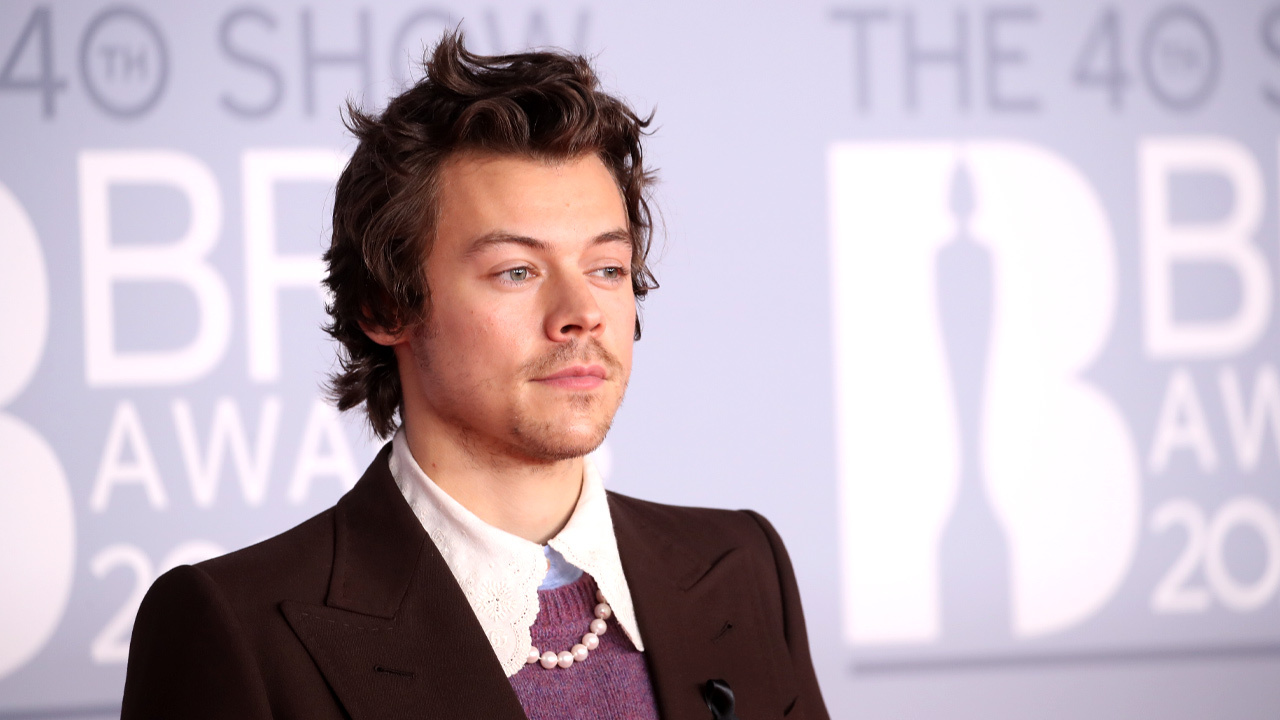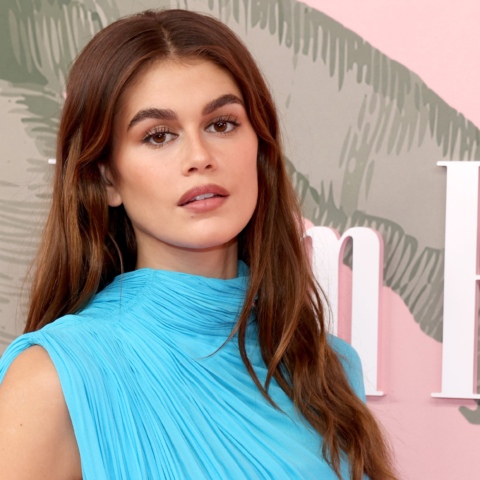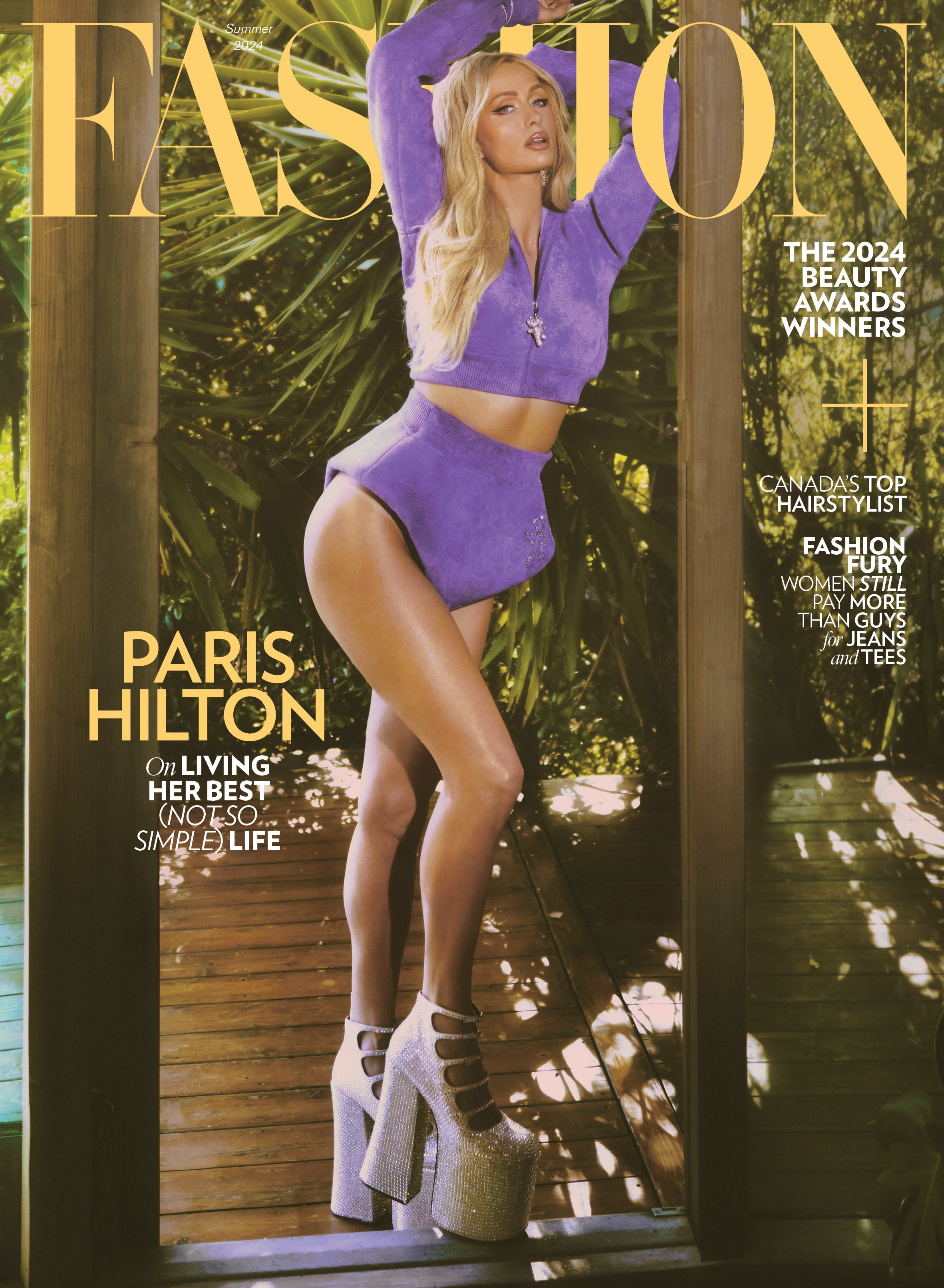People Are Debating the Meaning Behind Harry Styles’s Latest Video
Is he sexualizing women, queer-baiting or something else entirely?

Not a fan of watermelon? Well that’s about to change. On May 18, Harry Styles dropped the music video of the summer and simultaneously made everyone horny with the release of “Watermelon Sugar,” one of his hit tracks off his latest album Fine Line.
The video—which features Styles frolicking on the beach with a ton of models and watermelons—is honestly *sexual*. And features images like this:

And this:

Oh, and also this:

And we’ll never be able to look at a watermelon the same again. The music video—which the pop star dedicated “to touching”—is pretty much poised to be the video of summer 2020; but not everyone was über pleased with Styles’s latest release, with some fans taking issue with all of the cis-appearing women fawning over him. Why is that an issue? Well, since going solo after his 1D days, Styles has become known for his gender-bending dressing. He can often be spotted on a red carpet or on stage decked out in pearls, flow-y blouses and painted nails, and he honestly rocks it like no other.
He has also refused to comment on his sexuality. In a December 2019 interview with The Guardian, Styles told a reporter: ”It’s not like I’m sitting on an answer, and protecting it, and holding it back. It’s not a case of: I’m not telling you cos I don’t want to tell you. It’s not: ooh this is mine and it’s not yours…It’s: who cares? Does that make sense? It’s just: who cares?” Later, in the same interview, Styles commented on fans’ theories about “LGBTQ crumbs,” saying: “Am I sprinkling in nuggets of sexual ambiguity to try and be more interesting? No…I just think sexuality’s something that’s fun. Honestly? I can’t say I’ve given it any more thought than that.”
But while Styles may say he hasn’t given much thought to his sexuality and presentation of it, it’s very clear that his fans have—and some are saying that the latest video is a regression of the singer’s seemingly “woke” allyship.
There are *a lot* of great things about this video
Before we get into any critiques, it’s important to note that there’s *a ton* of great stuff about the video—including what went on behind the scenes. Because on top of having honey-smooth vocals, a wicked sense of style and hair that makes you want to run your fingers through it, it turns out that Styles is also a pretty good guy—and great to work with. Shortly after the video was released, Ephrata—a model who’s featured prominently in the video—talked about her experience on set in an Instagram Live video; specifically, she talked about what a joy Styles was to work with, calling him a “consent king.” Talking about interacting with Styles, Ephrata said: ”The people [on set] were telling him to touch my hair and play with it and he was like, ‘Wait, wait, wait, pause—can I even touch your hair? Is that even OK?’ And I was like ‘Yeah, that’s so nice. That was really sweet.'”
While the bar is pretty low, Ephrata’s comments make it clear that having that kind of treatment on set is *still* an anomaly; and the model said that Styles’s emphasis on making sure people were comfortable made the set and the shoot comfortable and welcoming for everyone. So we have to love that.
But for some fans, something seemed off
While the vid is undeniably fun to look at—with funky fashion and a hint of the summer many of us won’t be having (RIP summer 2020)—it didn’t sit 100% well for everyone. In an Instagram story shared on May 18, journalist Evan Ross Katz highlighted comments made by artist Gabriel Gomez. “Am I the only one that thinks that a harem of alt women rubbing fruit on their bodies & playfully worshipping a white, male pop star is slightly regressive content for someone that claims to be a ‘woke’ sexually-ambiguous ‘ally’?” Gomez asked, before inviting people to weigh in and share their own thoughts.
In response, Katz also shared his thoughts, writing: “You’re not missing something. Just because I don’t expressly see it doesn’t mean it’s not there.” Which is a *very* good point.
Looking at the video, it’s not that difficult to see where Gomez is coming from. This is far from the first time Styles has taken part in a seriously steamy vid (see: “Lights Up,” which features the sweaty, shirtless singer in a human mosh pit for a majority of the video).
But unlike “Lights Up,” which features myriad individuals, both male and female, “Watermelon Sugar” predominantly features female-presenting models (with the exception of two androgynous-looking men at the end of the video). With this in mind, it’s not hard to see how the writhing bodies in the new vid can be seen as servicing Styles and the male gaze—seemingly reminiscent of other, usually older videos that feature women objectified as background dancers.
On the flip side, the alternative might be queer-baiting
On the other hand, a small subsection of people on Twitter continued an ongoing debate over whether Styles’s latest video is just a continuation of what some say is the singer’s penchant for queer-baiting. FYI, queer-baiting is, per Xtra, when pop culture creators plant the seed of same-sex attraction to draw LGBTQ+ support but don’t allow that attraction to thrive. Think Toni Topaz and Cheryl Blossom (played by Vanessa Morgan and Madelaine Petsch, respectively) on Riverdale or the Madonna-Britney-Christina three-way kiss at the 2003 MTV Video Music Awards (a TBT). While the practice typically involves women (and as Xtra writer Stéphanie Vegre pointed out in an April 2019 article, is employed by females), it can also be utilized by male performers.
Andrew Murphy, Director of Programming at Inside Out, a not-for-profit charity that promotes, produces and exhibits films made by and about the queer community, points to Nick Jonas as a great example of this when he was promoting his show Kingdom and song “Jealous” in 2014. “It probably speaks more to the Hollywood system of managers and marketing PR people,” Murphy emphasizes. “[But] all of a sudden [Jonas] was jacked and on every cover of every queer magazine and was being talked about on every queer blog; and it was like ‘OK, everyone just settle down,'” he laughs. “That was queer-baiting at peak, peak, peak.”
In particular, many 1D fans compared the positive response to “Watermelon Sugar“ to negative responses aimed at Styles’s former bandmate Liam Payne, who some users claim has been called “biphobic” for similar music videos.
https://twitter.com/i/status/1262491723483119619
The idea of Styles using LGBTQ+ touchstones to engage queer audiences isn’t anything new. He’s been criticized online for it before, and even addressed it in his December 2019 interview with The Guardian, when asked about the album sleeve of his latest record, which features horizontal pink and blue stripes and a splash of magenta, colours and a design that reference the trans and bisexual pride flags.
Looking at the “Watermelon Sugar” video on first watch, something that stood out to me was the fact that the video predominantly features women; a fact noticeable enough that when the two men in the video *did* pop up, it felt obvious and intentional; like they were thrown in deliberately to deter anyone who thought Styles might be hinting that he’s straight. And this intentionality felt kind of off-putting.
“To an extent that’s part of it,” Murphy says of Styles’s addition of men late in the video, “but also, that may be his truth as well.” And, Murphy says, unless the singer is outwardly hurting a particular community, “I feel like, why not?” he says. “Why not have this kind of playing with gender and sexuality? Even if [Styles] has his little smirk on, that’s kind of saying ‘fooled you again,’ I think for anyone out there watching, it’s good to see these playfully sexual videos that are only about straight aligned sexual attraction.” And, Murphy says, even the suggestion [of bisexuality] could make someone feel that they’re part of a community or they’re part of something. “I personally don’t see anything wrong with it unless he’s very obviously playing something up that isn’t his truth.”
But for some, the “Watermelon Sugar” video isn’t guilty of objectifying women or queer-baiting
For Dr. Norma Coates, an associate professor in media and information studies as well as the department of music history at the University of Western Ontario, watching the video was an entirely different experience. While Coates (who focuses on pop culture and music) acknowledges that she can only speak to certain aspects of the video, as a straight white woman watching Styles on screen in his crocheted Gucci vest and funky sunglasses wasn’t watching a regression of the pop star’s “woke” image or an objectification of women. “I was looking at it [and] I didn’t see the sexuality centred on him,” Coates says. “Yes, there are a lot of women in [the video], but they did not seem as if they were servicing him, they were all servicing each other.” (BTW, Coates isn’t alone. Since the video debuted, many people online have been saying that the vid has *major* polyamory vibes).
And, as opposed to videos we may have seen from rock stars in the past, the emphasis in this video, when it comes to the women, isn’t on their bodies in an objectifying way. “The women’s bodies were not being shot to objectify them as many music videos that have women in support roles do,” Coates says. “They weren’t focusing on breasts; if anything, they were focusing on faces and the delight and the pleasure.” She points to an image early on of one of the woman feigning masturbation via a watermelon between her legs (FYI, “watermelon sugar” refers to oral sex); “Harry’s nowhere in sight,” Coates notes. “So it’s all about pleasure, specifically summer pleasure.”
For Coates, this emphasis on female pleasure (as opposed to Styles’s pleasure), is unique. “I thought it was very queer video in some ways,” she says, “and queer not as in sexually queer, but just queer as in queering the expected,” she continues. “You would expect these folks to be worshiping Styles. But again, I’m looking at it thinking: They’re all having fun with each other and enjoying each other’s bodies and physicality.”
“I don’t see it as a recourse to his rock star One Direction days with female adulation,” she says. “I just see him as being one of the girls hanging out on the beach.”
And, in fact, it fits what Styles has been telling us all along
Coates’s interpretation makes sense, because this idea of Styles as “one of the girls” is kind of what he’s been telling us all along—in that his persona is one that continuously queers gender, in the way he dresses and presents himself.
While pop music has always been a space for gender experimentation (Coates points to David Bowie as the ultimate example), she says that the current iteration of the space is “fascinating” at the moment, as male pop stars like Styles and fellow Brit Sam Smith, who identifies as non-binary, have more license and latitude to experiment with their gender presentation—and are more widely accepted for it (as they should be) than they might have been in the past. “We think about other teen idols who try to become grown-up stars, and it’s kind of almost violent masculinity or a kind of normative male sexuality,” Coates says. (Think Justin Bieber and his tattoos and sex-capades.) “Whereas Styles, knowing that he had all these young female fans, he is really queer as a pop star,” she says.
Which, normally (and unfortunately) may have been a gamble for some stars in the past; but Styles’s ability to do so, and be largely embraced for it, is refreshing, and also reflective of the time we’re in as a society.
“It’s true that he could also take most of his early fans with him [as he’s evolved] because things have really changed in terms of how gender is perceived and enacted, especially with younger people,” Coates says. Recalling a time when she was in graduate school studying post-structural feminism and reading Judith Butler and other feminist authors, Coates says, “I remember hearing an esteemed professor in women’s studies say ‘there are only two genders.’ And now gender has become more mutable and it’s not as unusual. I really admire all the young folks who are saying, ‘no, I’m going to refuse this gender system.” And in a way, she continues, that’s what Styles is doing too. “He is showing his audience that it’s OK and perhaps signalling that he’s in the same place as a lot of his fans, [showing] that gender is a construction. So he’s just constructing it the way he wants and at the same time reflecting what’s going on in culture at the moment.”
Plus, is it really Styles’s job either way?
For all the debate we’re having over Styles’s intentions, perhaps one question we should be considering is: Should we be reading into the video at all? As one Instagram user pointed out in Katz’s Insta stories, in many ways the pop singer can’t win. “We criticize him when it’s overly cis straight and criticize when it’s overly queer because we call out queer bating,” the social media user wrote. “We need to stop asking so much from a person who’s goal is to give us good music maybe?”
For both Coates and Murphy, the answer is yes. In this case, Styles can’t just be someone who purely puts out good music, independent of messaging and scrutiny for said messaging.
“Musical stars and celebrity are kind of the same thing,” Coates says. While she believes that people who are stars shouldn’t be in the position of speaking for the rest of us, there has been a change in how we view singers. Coates points to rock music in the 1960s. Because of the politics of the period, “all of a sudden, rock musicians became kind of the spokespeople for youth,” she says. An expectation that has held into modern music. And, because of the current economics of the industry—where artists have to be able to incite purchasing and mass streaming from their fans—”there are expectations [from fans],” Coates says of artists and the persona they put out. “But are those expectations correct? And should they be there and should he pander to them because he’s an artist?,” she asks.
“Honestly, I think that goes with the territory,” Murphy says of pop stars having to stand for something. While some artists may want to hire someone to deal with their messaging or remove themselves from causes and messaging at all, devoting themselves purely to recording and their music, that’s really not an option anymore. The artist as a person really can’t be separated from the art. “I think that if you just want to be a pop star or a rock star, that’s fine,” Murphy says. “But I think you really need to put your money where your mouth is these days. There isn’t room for that kind of oblivion and that kind of irresponsibility because at the end of the day, people look up to you. You do have a responsibility to your fans,” he continues. “You can make the music you want, you can play the music you want, but you need to be a good person.” With more access to celebs than ever via the world wide web, it’s now easier than ever for fans to look into who our fave celebs are as people; meaning that fans aren’t just interested in their favourite stars as singer or actors. ”When people look to people like [Styles], they love their music, but then when they peel back the layers, it’s like, OK, how is he behaving? What magazines does he appear on? What charities does he align himself with?”
And if we’re reading into the personal when it comes to Styles, it becomes very apparent that whatever his messaging may be in his videos, it appears largely authentic. “I hate to conjecture about who exactly he is, but I think that of all the people out there, he seems to be one of the good ones,” Murphy says of the singer. Speaking specifically to allyship, Murphy points to Styles’s charity work. The singer has aligned himself with Lady Gaga’s Born This Way Foundation as well as a Gay Straight Alliance in London. And in addition, while promoting Dunkirk in 2017, the singer wore a pair of Gucci loafers with a rainbow design, later donating the shoes to London-based LGBTQ+ organization London Friend, which promotes health and well-being.
In the big picture, Murphy points to Styles’s ongoing campaign encouraging fans to treat people with kindness. “It’s safe obviously, and it’s not specific to a sexual preference or gender,” Murphy says, “but if out of the gate one of today’s biggest pop stars is using the word kindness and asking people to be thoughtful about that, I think that we’re probably pretty lucky than what we could have ended up with.”
Ultimately, Styles hasn’t commented or shared his sexuality publicly (as is his prerogative, and frankly it’s none of our GD business), so let’s just stop guessing and enjoy the music. Because it’s A+.









